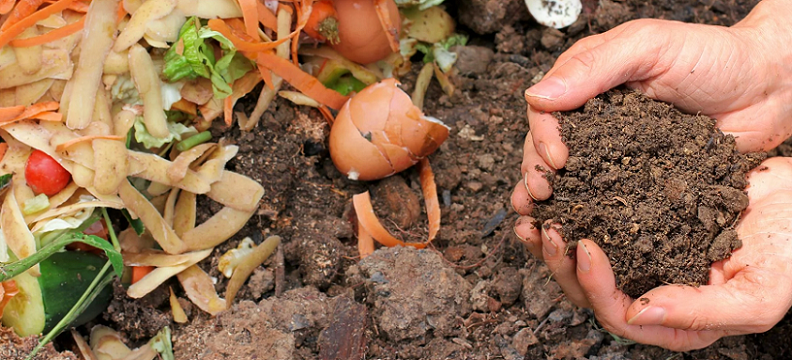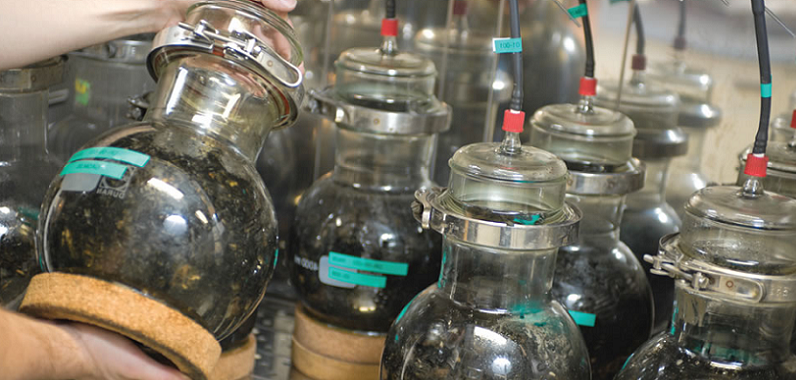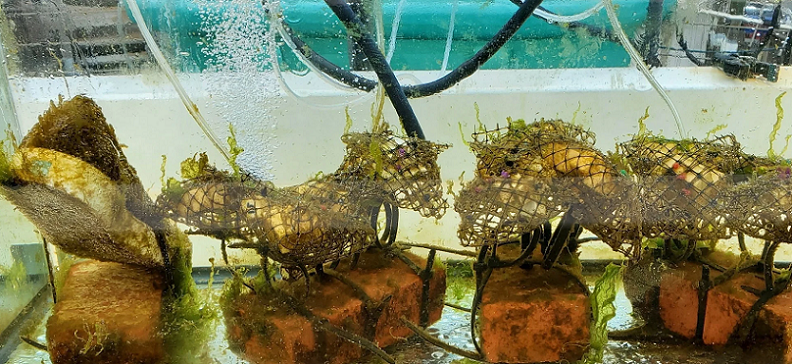
Nature has devised an ingenious way to clean up after itself: biodegradation. In our ever-changing world, the Earth is constantly faced with the challenge of managing waste materials. Fortunately, biodegradation plays a critical role in breaking down organic matter and restoring balance to our environment. Here we delve into the fascinating process of biodegradation, highlighting its importance in maintaining the Earth’s natural cycles.
Biodegradation: A Natural Recycling Process
Biodegradation is a remarkable natural recycling process that allows the Earth to maintain a balance within its ecosystems. It is a highly efficient and self-sustaining system that ensures the continuous recycling of nutrients and the reduction of waste. In this section, we will delve deeper into the intricacies of this process and understand its significance in preserving our environment.
Stages of Biodegradation
The biodegradation process can be divided into three main stages:
- Fragmentation: During this stage, large organic materials are mechanically broken down into smaller pieces by environmental factors or the action of detritivores, such as earthworms and insects. This fragmentation increases the surface area of the material, making it more accessible to microorganisms.
- Leaching: As rainwater or other water sources pass through the fragmented material, soluble components are dissolved and leached out. This process further breaks down the organic material, making it easier for microorganisms to access and metabolize.
- Microbial Decomposition: In the final stage, microorganisms like bacteria and fungi secrete enzymes that break down complex organic compounds into simpler substances. These simpler compounds can then be utilized by the microorganisms for growth and reproduction, while residual nutrients are released back into the environment, completing the nutrient cycle.
The Role of Enzymes
Enzymes play a crucial role in the biodegradation process. They act as biological catalysts, speeding up chemical reactions that break down complex organic molecules. Some common enzymes involved in biodegradation include:
- Cellulases: These enzymes break down cellulose, a major component of plant cell walls, into simple sugars.
- Ligninases: Ligninases decompose lignin, another vital component of plant cell walls, into smaller aromatic compounds.
- Proteases: Proteases break down proteins into their constituent amino acids.
- Lipases: These enzymes are responsible for breaking down fats and oils into glycerol and fatty acids.
- Amylases: Amylases break down starch, a carbohydrate found in many plants, into simpler sugars.
Microorganisms secrete these enzymes into their environment, allowing them to access the energy and nutrients stored in complex organic materials.

The Nutrient Cycle
Biodegradation plays a critical role in maintaining the Earth’s nutrient cycles. As organic materials are broken down and decomposed, essential nutrients such as carbon, nitrogen, and phosphorus are released back into the environment. These nutrients are then made available to plants and other organisms, ensuring the continuous circulation of essential elements within ecosystems.
For example, the carbon cycle is a fundamental process that enables the exchange of carbon between living organisms, the atmosphere, and the Earth’s crust. Biodegradation contributes to this cycle by breaking down organic materials, releasing carbon dioxide and methane into the atmosphere, which can then be absorbed by plants during photosynthesis.
Similarly, biodegradation plays a vital role in the nitrogen cycle. As proteins and other nitrogen-containing compounds are decomposed, nitrogen is released into the environment in various forms, such as ammonia, nitrate, and nitrite. These forms of nitrogen can be utilized by plants and other organisms, ensuring the continuous availability of this essential nutrient.
Types of Biodegradable Materials
Biodegradable materials are those that can be broken down by living organisms, particularly microorganisms, into simpler substances. These materials play a crucial role in the natural recycling process of biodegradation, helping to reduce waste accumulation and pollution. In this section, we will explore the various types of biodegradable materials, including natural and human-made materials, and their significance in environmental sustainability.
Natural Materials
Natural materials are organic substances derived from plants, animals, or other living organisms. They are inherently biodegradable and can be broken down by microorganisms in the environment. Some common examples of natural materials include:
- Plant materials: Plant-based materials such as leaves, wood, and fibers are biodegradable and contribute to the nutrient cycles in ecosystems. These materials are composed of cellulose, lignin, and other organic compounds that can be broken down by bacteria and fungi, releasing nutrients back into the environment.
- Animal materials: Animal-derived materials, such as bones, hair, and waste, are also biodegradable. These materials contain proteins, fats, and other organic compounds that can be decomposed by microorganisms, returning essential nutrients like nitrogen and phosphorus to the environment.

Human-made Materials
In response to the environmental challenges posed by non-biodegradable materials like traditional plastics, researchers and manufacturers have developed a range of human-made biodegradable materials. These materials are designed to break down more efficiently in the environment, reducing waste accumulation and pollution. Some examples of human-made biodegradable materials include:
- Biodegradable plastics: Biodegradable plastics are made from renewable resources, such as corn starch, sugar cane, and vegetable oils, or from synthetic polymers that have been engineered to break down more easily. These plastics can be decomposed by microorganisms, releasing carbon dioxide, water, and biomass as by-products. Examples of biodegradable plastics include polylactic acid (PLA), polyhydroxyalkanoates (PHA), and polybutylene adipate terephthalate (PBAT).
- Biodegradable cleaning agents: Biodegradable cleaning agents, such as detergents and soaps, are made from natural or synthetic ingredients that can be broken down by microorganisms in the environment. These cleaning agents minimize the impact of household and industrial waste on water quality and aquatic ecosystems.
- Biodegradable packaging materials: Biodegradable packaging materials, such as paper, cardboard, and biodegradable films, are designed to break down more quickly than traditional packaging materials, reducing waste accumulation and pollution. These materials can be composted or decomposed by microorganisms, returning nutrients to the environment and supporting sustainable waste management practices.
By incorporating biodegradable materials into our daily lives and industries, we can support the natural recycling process of biodegradation and reduce the environmental impact of waste materials. By choosing products made from biodegradable materials and disposing of them responsibly, we can contribute to a more sustainable and environmentally friendly future.
Environmental Benefits of Biodegradation
Biodegradation is a natural recycling process that plays a vital role in maintaining the health of our environment. By breaking down organic materials and recycling essential nutrients, biodegradation helps to reduce waste accumulation, mitigate pollution, and support the Earth’s nutrient cycles. In this section, we will explore the numerous environmental benefits of biodegradation, emphasizing its importance in preserving our planet for future generations.
Reduction of Waste Accumulation
One of the most significant benefits of biodegradation is its ability to reduce waste accumulation in landfills, oceans, and other ecosystems. As biodegradable materials break down, they are converted into simpler compounds that can be absorbed by plants, animals, and microorganisms, effectively reducing the overall volume of waste. This reduction in waste accumulation helps to:
- Preserve natural habitats and ecosystems by preventing waste-related pollution and habitat destruction.
- Reduce the demand for landfill space, minimizing the environmental footprint of waste disposal.
- Lower the risk of harmful substances leaching into the soil, water, and air, thus protecting the health of humans, animals, and plants.

Contribution to Nutrient Cycles
Biodegradation plays a critical role in maintaining the Earth’s nutrient cycles, such as the carbon, nitrogen, and phosphorus cycles. As organic materials are broken down and decomposed, essential nutrients are released back into the environment. These nutrients are then made available to plants and other organisms, ensuring the continuous circulation of essential elements within ecosystems. By contributing to these nutrient cycles, biodegradation:
- Supports plant growth and productivity, providing food and habitats for other organisms.
- Promotes biodiversity by maintaining nutrient-rich environments that can support a wide range of species.
- Helps regulate atmospheric levels of carbon dioxide and other greenhouse gases, mitigating the effects of climate change.
Restoration of Soil Health
Biodegradation is vital for maintaining and restoring soil health, as the decomposition of organic materials contributes to the formation of nutrient-rich humus, a critical component of healthy soil. The presence of humus improves soil structure, water retention, and nutrient availability, promoting the growth of plants and the overall productivity of ecosystems. By restoring soil health, biodegradation:
- Enhances agricultural productivity by providing fertile soil for crop growth.
- Supports reforestation and afforestation efforts by creating suitable environments for tree growth.
- Helps combat desertification and land degradation by maintaining healthy and resilient ecosystems.
Mitigation of Pollution and Greenhouse Gas Emissions
Biodegradation can help mitigate pollution and reduce greenhouse gas emissions by breaking down harmful substances and converting them into less toxic or inert compounds. For example, the decomposition of organic waste in landfills generates methane, a potent greenhouse gas. By promoting the biodegradation of organic materials through composting or anaerobic digestion, we can capture methane and use it as a renewable energy source, reducing greenhouse gas emissions and contributing to climate change mitigation.
The biodegradation of human-made materials, such as biodegradable plastics and cleaning agents, can help reduce the environmental impact of these substances by breaking them down into less harmful or inert compounds. This process can minimize water and soil pollution and protect the health of aquatic and terrestrial ecosystems.
Bioremediation: Harnessing Biodegradation for Environmental Cleanup
Bioremediation is an innovative and eco-friendly approach that harnesses the power of biodegradation to clean up contaminated environments. Bioremediation is a process that employs living organisms, primarily microorganisms such as bacteria, fungi, and algae, to break down harmful pollutants and contaminants in the environment. These microorganisms metabolize and detoxify hazardous substances, converting them into less harmful or inert compounds. Bioremediation can be used to treat a wide range of contaminants, including petroleum hydrocarbons, heavy metals, pesticides, and organic solvents.
Principles of Bioremediation
Bioremediation is based on the principle that living organisms, primarily microorganisms such as bacteria, fungi, and algae, can break down or transform harmful substances into less toxic or inert compounds. These microorganisms use pollutants as a source of energy and nutrients, metabolizing them through enzymatic reactions and converting them into simpler substances that can be safely integrated into the environment. Bioremediation can be applied to a wide range of pollutants, including heavy metals, pesticides, petroleum hydrocarbons, and industrial chemicals.
Techniques of Bioremediation
There are several techniques used in bioremediation, which can be broadly classified into two categories: in-situ and ex-situ.
In-situ Bioremediation
In-situ bioremediation involves the treatment of contaminated soil or groundwater at the site of pollution. This approach minimizes the need for excavation or transport of contaminated materials, reducing costs and environmental impacts. Some common in-situ bioremediation techniques include:
- Bioventing: This method involves the injection of air into the contaminated soil to stimulate the growth and activity of aerobic microorganisms, which break down pollutants like petroleum hydrocarbons.
- Biosparging: Similar to bioventing, biosparging involves injecting air into contaminated groundwater to promote the aerobic biodegradation of pollutants.
- Bioaugmentation: This technique involves the addition of specific microorganisms to contaminated sites to enhance the biodegradation of target pollutants.
Ex-situ Bioremediation
Ex-situ bioremediation involves the removal of contaminated materials from the site of pollution and their treatment in a controlled environment. While this approach can be more expensive and disruptive than in-situ methods, it allows for greater control over the treatment process. Some common ex-situ bioremediation techniques include:
- Landfarming: Contaminated soil is spread over a large area and periodically tilled to promote the aerobic biodegradation of pollutants.
- Biopiles: In this method, contaminated soil is placed in piles and aerated to stimulate microbial activity and pollutant breakdown.
- Composting: Contaminated materials are mixed with organic matter and allowed to decompose in a controlled environment, promoting the biodegradation of pollutants.

Encouraging Biodegradation and Sustainable Practices
Promoting biodegradation and adopting sustainable practices are essential for preserving our environment and ensuring a healthy planet for future generations. By making conscious choices in our daily lives, supporting eco-friendly policies, and implementing sustainable waste management practices, we can collectively contribute to a cleaner and more resilient environment.
Personal Choices and Lifestyle Changes
Individual actions can have a significant impact on the environment, and by making small changes in our daily lives, we can support biodegradation and contribute to a more sustainable future. Some steps we can take include:
- Use biodegradable products: Choose biodegradable alternatives for everyday items, such as cleaning supplies, personal care products, and packaging materials. Look for products made from natural or compostable materials that can be easily broken down by microorganisms.
- Reduce, reuse, and recycle: Practice the three Rs—reduce, reuse, and recycle—by minimizing waste, repurposing items, and recycling materials whenever possible. This approach helps to conserve resources, reduce waste accumulation, and support the natural recycling process of biodegradation.
- Composting: Create a compost pile or bin for your kitchen scraps, yard waste, and other biodegradable materials. Composting not only supports the biodegradation process but also provides nutrient-rich compost that can be used to fertilize plants and improve soil quality.
- Support eco-friendly policies: Advocate for and support policies that promote sustainable practices, such as regulations encouraging the use of biodegradable materials, waste reduction initiatives, and recycling programs.
Sustainable Waste Management Practices
Implementing sustainable waste management practices is crucial for maximizing the potential of biodegradation and reducing the environmental impact of waste. Some key practices include:
- Source separation: Encourage the separation of biodegradable waste from non-biodegradable waste at the source, such as households and businesses. This approach facilitates more efficient recycling and composting processes, ensuring that biodegradable materials are properly managed and returned to the environment.
- Composting facilities: Establish community or industrial-scale composting facilities to process biodegradable waste, converting it into valuable compost that can be used for agriculture, horticulture, and landscaping purposes.
- Anaerobic digestion: Promote the use of anaerobic digestion, a process that breaks down biodegradable waste in the absence of oxygen, producing biogas and nutrient-rich digestate. Biogas can be used as a renewable energy source, while the digestate can be applied as a fertilizer, further supporting the nutrient cycle.
- Bioremediation projects: Support and invest in bioremediation projects that leverage the power of biodegradation for environmental cleanup, restoring contaminated ecosystems, and protecting human health.
Collaboration and Education
Encouraging biodegradation and sustainable practices requires collaboration and education at all levels of society. By fostering partnerships among individuals, communities, businesses, and governments, we can develop and implement effective strategies for promoting biodegradation and sustainability.





